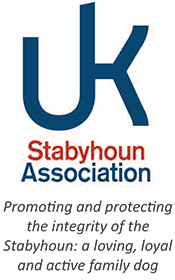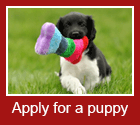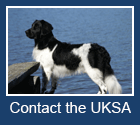Getting to know and training your Stabyhoun
As with any dog you need to understand it before you start training. The Stabyhoun falls within the Kennel clubs HPR (Hunt, Point, Retrieve) group which means they were originally bred, amongst other things, to hunt and locate game at long distances for the hunter. This means it is important to train a good recall from your Stabij and teach them from a young age not to stray too far from you on a walk. Unless of course you are going to be hunting with your dog, in which case you will also teach a command for your dog to go and hunt. These dogs were also used to hunt vermin, in particular moles, and to assist with the herding of animals. So, as you can imagine they quite often have a high prey drive.
This doesn’t mean that they don’t make good family pets, in fact quite the reverse, in general they are intelligent, loving, loyal, family dogs who love to be with you and be involved in what you are doing. They are also very versatile and can be trained for almost anything you would like them to do.
So how do we go about the training? Firstly, if you have bought a UK puppy he/she will arrive with you at about 8 weeks old and the first thing we need to do is socialisation. Puppy needs to see, hear and experience as many different things as you can think of before the socialisation window starts to close at 12 weeks of age. There are now some really good Apps that you can download of different sounds such as, fireworks, thunder, gunshot, etc, which you should start playing at low volume and gradually increasing so that puppy associates them with a pleasurable experience such as food or play. We also, need to take puppy outside the home to experience different situations and sounds. Although, at this age we would advise not putting them on the ground outside of your own garden, they can be carried or you can use a puppy pram, although it is better if puppy is carried by you. If, for example they find the first lorry they see rather frightening then they have comfort and security from you so the whole situation will be that much better for them. So, take your puppy wherever you can both in town and in the countryside and on plenty of car journeys to build confidence, mental stability and a well socialised pup.
Be very careful when introducing your puppy to other dogs, if they have a bad experience with the other dog being over boisterous or not tolerant of puppies, this can have a lasting effect and cause your puppy to be fearful of other dogs later in life. This also applies to any negative situation, therefore we need to be over-protective parents and not let anything bad happen to our puppy, not only during the socialisation period but until they have matured at about 14 months. They will also experience two fear impact periods prior to this age where emotive things can have a lasting effect. On a plus side this also applies to good things so early positive reinforcement training is a must.
Actual training at this early age could include crate training, getting them used to collar and lead, sits, downs, recall, retrieve, isolation and settle on a bed. Where a lot of people go wrong is that they spend a huge amount of time training tricks and then wonder why further down the line the pup has problems. For example, with loose lead walking, recall, jumping up, etc. The easy answer is that it was because they never actually trained these exercises.
During this four-week period, while waiting for puppy to finish their vaccination course and to be officially allowed out, it is an ideal time to look into local training classes and find one that is going to suit you. The Kennel Club have a list of accredited instructors, as do several other training organisations. Ask if you can go and watch a class to see if it is for you before signing up. Also, you could ask other people where they go for training, as there is nothing like a personal recommendation. Anyone can put together a flashy website, but it doesn’t mean that they are necessarily a good trainer.
Things to look out for; a good trainer will have knowledge of different breeds and be able to be adaptive in their methods to suit different dogs, they should have good control over their class and spend equal time with people and there should also be an assistant available to help anyone having difficulty. The classes should be well structured and use positive reinforcement methods such as play, praise, food or the best would be a combination of all three. If you don’t like what you see, then don’t be frightened to walk away.
Beware of puppy socialisation classes where several puppies are let off the lead to play with each other, as this can be a very negative experience for a puppy. The bullies will pick on the shyer puppies which can have a lasting effect on their temperament. Good socialisation for a puppy is to see other dogs but not be put under any pressure.
So now puppy has finished their course of vaccinations and is allowed out in the big wide world and we are starting to take them for walks. There are a lot of different thoughts as to how long we should walk our puppies from a young age, some would advise 5 minutes for every month of life, this might be a good idea if you have a very large breed dog such as a Newfoundland, Great Dane, etc. but with smaller breeds you could certainly do a bit more. The thing to remember is not to exercise a puppy when it is tired, as that is when the damage is done and be sensible if you walk half an hour from home then it is another half an hour to get back. Although, puppy might be very energetic on the way out, he could become very tired on the way back. If this does happen either pick him up and carry him or sit down for half an hour and let him have a nap on your lap.
Regarding playing and exercising at home, how long should you let puppy play for? The answer is; for as long as he wants as he will stop of his own accord and have a nap when he is tired. Although, if you are interacting with him he may become over stimulated and over tired in which case make sure he is taken to his bed or pen for some quiet time at regular intervals, especially if he is getting over excited playing with children.
When out walking your puppy remember this is all valuable training time. It is important that you take not only your poo bags with you but a toy or treats to reward your dog for good behaviours. Things we can train on a walk could include; loose lead walking, leave it command, meet and great people in the correct way (i.e. sit for attention, don’t jump up), to walk nicely past other dog walkers and connect with you and recall on lead (don’t be in a hurry to let your dog off the lead before you have taught the recall).
Remember your puppy is soaking up information like a sponge at this age and everything you let it do, means you are actually training it to do, so be careful. If you let your dog go to the end of the lead when it sees another dog or person and say “go say hello” then in effect you are telling him it is okay to go up to every dog/person he sees and demand attention, which as he grows older will end up with him pulling on the lead every time he sees something and running off when he is eventually off the lead, effectively we are teaching him to do this at a young age. Everything you teach your puppy at a young age will stay with them for life so it is up to us to give them the right education, as we would our children.
The Stabyhoun does have quite a high prey drive, they like to sniff out wildlife, etc and follow the scent and the animal. At an early age we need to teach them to not do this if it is something we don’t want them to do or if you are going to be hunting with your dog then to do it in a controlled manner. I mentioned earlier about not letting your dog off the lead until you have taught the recall command but although you might have a 100% recall in the garden or at a training class these are controlled situations. We now need to prove this exercise in the real world. When you first let puppy off the lead out on a walk it is a good idea to use a 10 meter longline and have a transitional stage, this way you are teaching your puppy to stay close to you when walking and if you call your puppy back and they don’t respond you can make it happen and reward rather than let puppy go wrong. It is important that when we let our dog off the lead that we give them something to do, if we don’t they will find us boring and start going off to look for something more interesting. So, take a toy out with you and show your puppy the toy that we want him to chase and interact with him.
Also remember to reward him every time he checks in with you.
Have fun!
It is important to use a mixture of play and food rewards when training, if you rely solely on treats then you are building a relationship between the puppy and the food and not with yourself. A puppy wants to play and chase, let’s give him that chase and play with the toy, this way he is getting what he wants from us and we are building a firm bond with our dog.
Puppies grow up very quickly, don’t miss this window of opportunity to get in all the basic training that they need. Enjoy this time with them. The more you train them the more they will love you and you will build a lifelong relationship with your Stabij.
Helen Withey FBIPDT PE
Book list
The Perfect Puppy – Gwen Bailey ISBN 0-600-58581-6
For owners who want to know how to bring their puppy up to be a happy well behaved and friendly adult dog.
Dogs Behaving Badly – Gwen Bailey ISBN 0-00-717492-6
Advice for dogs of all ages this is a practical problem solver to transform an unruly dog into an obedient pet. Providing practical information on a range of common problems.
“Stop” How to control predatory chasing David Ryan ISBN 978-1-4092-5827-8
This book explains the reason s behind predatory chase and how to control the behaviour.
Total Recall – Pippa Mattinson ISBN 978-1-84689-149-6
Learn how to use modern reward-based training methods effectively, this book takes you through step-by-step the process of creating a powerful and permanent recall
On Talking Terms with Dogs – Trudi Rugaas ISBN 978 -1-929242-36-0
Learn to identify situations that are stressful to your dog so that you can solve or aviod them. Become a better observer of your dogs behaviour and build a solid relationship.
Understanding and Handling Dog Agression Barbara Sykes ISBN 1-86126-426-3
Barbara clearly explains how to understand hostility in dogs and advises owners how to educate their dogs sympathetically to subdue it’s aggression.
Follow Me – a deal with your dog – Eva Bodfaldt ISBN 978-91-973578-5-2
A general training manual for all the basics and especially how to train your dog to have better contact with you when out, to be obedient not to run off and have a good relationship with you.
Force Free Gundog Training : The Fundamentals for Success – Jo Laurens ISBN 1527246507
A book which helps to equip you with the necessary skills and knowledge to begin training a working gundog using modern, force-free, and effective methods. This book includes discussion of the fundamental principles behind successful force-free gundog training
The Forever Dog – Rodney Habib & Dr Karen Shaw Becker
Two of the world’s most popular and trusted pet care advocates reveal new science to teach us how to delay ageing and provide a long, happy, healthy life for our canine companions. The definitive, cutting-edge guide for every dog parent.








